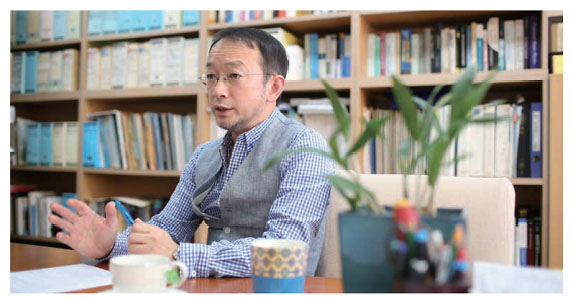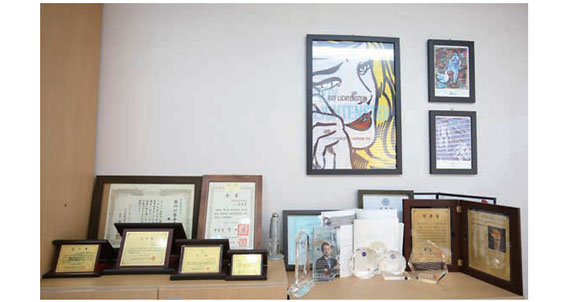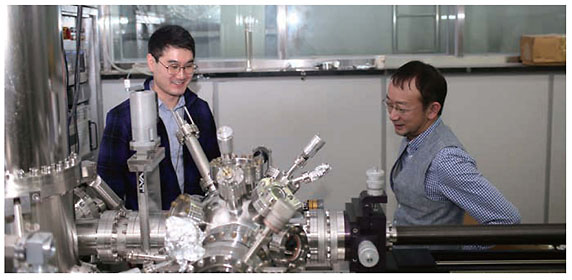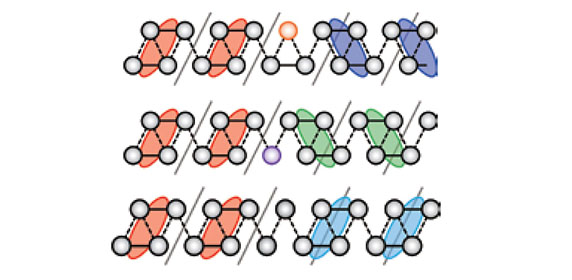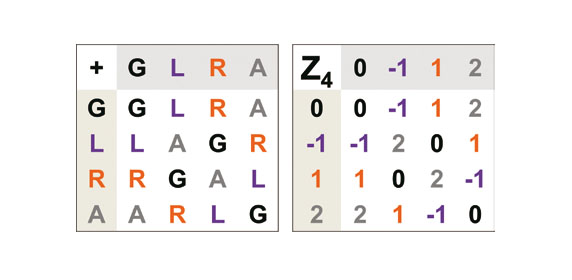주메뉴
- About IBS 연구원소개
-
Research Centers
연구단소개
- Research Outcomes
- Mathematics
- Physics
- Center for Underground Physics
- Center for Theoretical Physics of the Universe (Particle Theory and Cosmology Group)
- Center for Theoretical Physics of the Universe (Cosmology, Gravity and Astroparticle Physics Group)
- Dark Matter Axion Group
- Center for Artificial Low Dimensional Electronic Systems
- Center for Theoretical Physics of Complex Systems
- Center for Quantum Nanoscience
- Center for Exotic Nuclear Studies
- Center for Van der Waals Quantum Solids
- Center for Relativistic Laser Science
- Chemistry
- Life Sciences
- Earth Science
- Interdisciplinary
- Center for Neuroscience Imaging Research (Neuro Technology Group)
- Center for Neuroscience Imaging Research (Cognitive and Computational Neuroscience Group)
- Center for Algorithmic and Robotized Synthesis
- Center for Genome Engineering
- Center for Nanomedicine
- Center for Biomolecular and Cellular Structure
- Center for 2D Quantum Heterostructures
- Center for Quantum Conversion Research
- Institutes
- Korea Virus Research Institute
- News Center 뉴스 센터
- Career 인재초빙
- Living in Korea IBS School-UST
- IBS School 윤리경영


주메뉴
- About IBS
-
Research Centers
- Research Outcomes
- Mathematics
- Physics
- Center for Underground Physics
- Center for Theoretical Physics of the Universe (Particle Theory and Cosmology Group)
- Center for Theoretical Physics of the Universe (Cosmology, Gravity and Astroparticle Physics Group)
- Dark Matter Axion Group
- Center for Artificial Low Dimensional Electronic Systems
- Center for Theoretical Physics of Complex Systems
- Center for Quantum Nanoscience
- Center for Exotic Nuclear Studies
- Center for Van der Waals Quantum Solids
- Center for Relativistic Laser Science
- Chemistry
- Life Sciences
- Earth Science
- Interdisciplinary
- Center for Neuroscience Imaging Research (Neuro Technology Group)
- Center for Neuroscience Imaging Research (Cognitive and Computational Neuroscience Group)
- Center for Algorithmic and Robotized Synthesis
- Center for Genome Engineering
- Center for Nanomedicine
- Center for Biomolecular and Cellular Structure
- Center for 2D Quantum Heterostructures
- Center for Quantum Conversion Research
- Institutes
- Korea Virus Research Institute
- News Center
- Career
- Living in Korea
- IBS School
News Center
| Title | Korean scientists standing independent and jumping into new research | ||||
|---|---|---|---|---|---|
| Name | Communications Team | Registration Date | 2018-02-06 | Hits | 4468 |
| att. |
 thumb.jpg
thumb.jpg
|
||||
Korean scientists standing independent and jumping into new research- Director Yeom Han Woong (Professor at POSTECH) of the Center for Artificial Low Dimensional Electronic Systems - On August 31, 2017, Director YEOM Han Woong of the IBS Center for Artificial Low Dimensional Electronic Systems was appointed vice chair of Presidential Advisory Council on Science & Technology. In March, before his appointment, Director Yeom worked for then-candidate MOON Jae-In’s campaign team as a science technology advisor and now offers his thoughts on science and technology policies to the president. In addition to assisting the president, Director Yeom has expanded the Center for Artificial Low Dimensional Electronic Systems’ international presence in the field of nanoscale atomic line research. In his POSTECH office, the Director shared his ambition as the vice chair of Presidential Advisory Council on Science & Technology, research outcomes, and plans for the future. Initiatives as vice chair of Presidential Advisory Council on Science & Technology“The new administration decided to create a committee, bringing together the National Science and Technology Council and Presidential Advisory Council on Science & Technology. It will serve as a science and technology control tower which provides policy advice and is in charge of relevant budget and deliberation. The committee oversees R&D related matters of not just the Ministry of Science and ICT, Office of Science and Technology Innovation, but also other Ministries including the Ministry of Trade, Industry and Energy and Ministry of Health and Welfare,” said Director Yeom. At the Advisory Council, its members discuss policies that can advance science technologies and help the country benefit from those technologies. Based on such discussion, they consult the president. They also monitor whether the administration has taken the advisement into account. With the marriage of the Advisory Council and National Science and Technology Council, the combined council is left with a renewed sense of responsibility and presence.
“At Moon’s campaign team, I drafted direction for science and technology policies. The direction has developed into more concrete pledges. When Moon was elected, they became part of the presidential agenda,” explained Yeom. He added, “Some suggested it would be reasonable for the creator of framework to run the ideas. That’s how I was appointed,” said the Director. The Director is working to construct science & technology polices around opinions from the science community. Most of the national policies have been research projects for commercial use that can pick up short-term industrial competitiveness. “Plenty of commercial research is carried out at the private sector. Now it’s time for the government to establish longterm policies, putting basic science and public welfare technologies at the center,” said Director Yeom. He is committed to offering long-term support for basic science. The vice chair is very much aware that people are critical of the Institute for Basic Science, a research hub he is a part of. “IBS was founded to give a solid boost to domestic basic science research to raise our capability to match the global level of basic research. Some belive that desperate remedy created a distortion in the research ecosystem,” said Yeom. To provide a fix to the situation, he presented ways that can bring harmony to the entire science and technology landscape. “The incumbent administration will provide a support for what has been neglected in the former government. We will put in place a system that supports creativity of individual researchers,” he explained. The statement shows that a research support system centering on researchers is at the heart of R&D innovation plans. Independent researchers look to governmentfunded research foundations for much needed funding. Currently a KRW one trillion budget is put aside for such purpose and he plans to double the amount for the next five years. Dr. Yeom also mentioned that no other country in the world, except for China, is increasing their basic science budget, making the Korean government’s move all the more remarkable. A heavyweight scientist respected at home and abroadAs of October 20, 2017, Director Yeom became a fellow of the American Physical Society. Seven years ago, the same society gave him the title “Outstanding Referee”. He is one of the most frequently publishing researchers in Korea to APS journals, including Physical Review Letters. Due to such accomplishments, he is frequently asked by APS to review academic publications and was granted the title. With the recommendation from fellow scientists, his research on atomic line won him a fellowship at APS. The recommendation letter elaborates his research achievement that, from 1997 to 2007, he discovered four exotic phase transitions of atomic line. Phase transition refers to transitions between solid, liquid and gaseous states of matter.
“Research in physics requires scientists to synthesize new materials or find a new material property from a known material. One of noticeable new properties is phase transition. In Korea's one hundredyear history of solid-state physics, there are only a handful of cases where new materials were synthesized for the first time. There are even fewer new property discoveries. This makes my early research on phase transitions of atomic line noteworthy discoveries.” In 2015, he published a paper in Science. In his publication, he presented an interesting atomic line. In a conventional conductor wire, electrons flow in a large quantity. He discovered a 1nm indium atomic line which has an information carrier designed to move a single electron at a time. If such a single electron device that processes one bit of data per electron is introduced, energy consumption will be reduced and overheating won’t be a problem. This, in turn, is expected to expedite the creation of a smaller integrated circuit. That year, he was honored the Korea Science Award and received the Inchon Award a year later. Last February, he published research updates in Nature Physics. In his research, he established the quaternary numeral system using an information carrier of indium atomic line. It implies that the carrier has the potential to create a new data storage and computing device. The vice chair emphasized that this finding is even more significant than the previous one. Recognized with his new achievement, he received the Kyung-Ahm Prize last September. His 20-year dedication to atomic line research that started in 1997 has rewarded him with a series of admirable outcomes. A lesson from JapanHe majored physics at Seoul National University, received master’s degree in physics from POSTECH, and moved to Japan to complete his PhD from Tohoku University. His studies in Japan and the Physical Society of Japan made him the man he is today. “I wanted to stay local for my studies. Unfortunately the SNU graduate school didn’t have enough experimental equipment. POSTECH, while it was well-equipped and owned a synchrotron accelerator, didn’t have seasoned advisors who can guide students based on personal experience. Therefore, I decided to venture out of the country. There were outstanding researchers who conduct research in my field in Germany, Sweden, and Japan. I sent e-mails to some of them, saying I am committed and will work hard. This led me to a new journey at Japan,” said Yeom. The Director was in a non-degree program for six months and completed his PhD within two and a half years. The university in Japan owned all necessary equipment. When students have ideas, they can try them, and when something didn’t work out during an experiment, professors were there to offer them direction. Director Yeom still recalls those stimulating moments where professors with great expertise advised him on his research, freeing him from researcher’s block. His supervisor at Tohoku University dedicated himself to creating a single-atom layer on a semiconductor substrate since the early 1990’s. He developed the layer by metalizing it in an ultra-high vacuum environment. With this method, a thick layer of atoms is generated. To make it an evenly spread single-atom-thick layer, researchers need to use a specific material. A British research team generated a single-atom layer of graphene from graphite using Scotch tape. The finding shaped single-atom layer physics research around graphene. However the method is limited as researchers can create only 2D material flakes, including graphene flakes which are invisible. The Professor explained that to commercialize the technology, graphene devices need to be generated, and therefore, current research projects are aimed to develop larger sheets with consistent thickness. Typically researchers use a large 30cm wafer to create tens of thousands of commercial devices. Due to these reasons, a vapor disposition method is an effective mean to grow the scale of 2D materials and commercialize them. Dr. Yeom’s PhD research was on atom layer 2D materials, mostly metallic single-atom layer materials. He expanded his research from metallic single-atom layer to all single-atom layers from 1997. He stressed that he practically founded the research field on electronic properties of singleatom layers. How to become a top-notch researcherIn January of 2000, he was offered to be an associate professor at Yonsei University. Coming back to Korea was not on his mind, but the question that came with the offer convinced him. It asked if he would like to use what he learned for the benefit of his country and people. Even after joining the university, the Director took on a Science Research Center project for four years, conducting research using a synchrotron accelerator. In 2003, he launched the Center for Atomic Wires and Layers, one of the National Creative Research Initiative Centers. He was the youngest researcher to serve as the Director for one of the Centers and his project continued for nine years. “Once you take your idea and run with it for five to six years, you may have squeezed all you can get out of that idea. That’s when you should go to step two. Around 2007, after completing the second phase of the National Creative Research Initiative project, I looked back on all of my research. I wanted to find out what I should do to take my research up a notch,” said the Director. He looked for advice from senior researchers, but failed to find an answer until he heard about Chinese researchers whose research presence grew dramatically. Qikun Xue, his colleague at Tohoku University, returned to China as he was selected for the National Project for Thousand Outstanding Young Scientists. From 2006, he produced an impressive number of quality papers. To discover the drive behind his success, Director Yeom visited his friend’s lab in China. Ample financial support for research is a part of the reason for his success, but his research group, run by him and three assistant professor level researchers was the main driver. Around 2010, Xue’s research team entered the international spotlight. Now he is the vice president for research at Tsinghua University and is one of top contenders in the running to win the Nobel Prize. “In Japan, typically a professor, an associate professor, and two assistant professors are in one lab. The lab I worked in Japan had similarly constructed members. It goes the same in Germany. In the U.S., one professor operates a project, but he/she is joined by three to four talented postdocs. In Korea, one professor is responsible for 10 graduate students. It’s hard to conduct preeminent research while also offering guidance to all those students,” said Dr. Yeom. The realization is why he decided to leave Yonsei University and take a job at POSTECH as the university offered him a generous research fund and two to three assistant professors. In 2010, at the new job, he created a German style research team and carried out research that wasn’t possible before. In three years, he became the Director of the IBS Center for Artificial Low Dimensional Electronic Systems. He explained, “IBS establishes a Center where one director and seven to eight post-doctoral researchers work together. This shows that IBS shares my philosophy. One unexpected factor is that the government was very generous with research fund and supported us with double or triple the amount I originally thought possible.”
A brand new information processing technology, solitonicsFrom 2012 to 2017, Director Yeom focused solely on finding a new data storage material. His research has focused mainly on indium atomic line. In 2012, he discovered solitons using a scanning tunneling microscope (STM) and the relevant research was published. He was then the first to identify chiral solitons from indium atomic line, a one-dimensional material, and the 2015 finding was published in Science. In 2017, in his publication in Nature Physics, he proved that it is possible to process information in the quaternary numeral system using chiral solitons.
What is soliton? Director Yeom gave the definition, taking seismic sea wave as an example. “Soliton is a solitary wave that propagates with constant velocity while retaining its shape when the wave is caused by a certain medium with a special condition (nonlinear condition),” explained Dr. Yeom. He added, “Once seismic waves ripple through, they travel thousands of kilometers, maintaining their power. Soliton is not different from such waves.” The soliton phenomenon has been documented from the late 1800’s, and in the early 1980’s it was discovered that electrons, which behave as waves, can generate soliton waves. When turned into soliton waves, electron waves can contain information. Soliton waves can travel long distances without being interrupted by outside factors, indicating that once information is entered, it is saved for good. In 2012, Director Yeom found a method to observe a single soliton using a microscope. Since the discovery, he created chiral solitons which exhibit four states 0, -1, 1, and 2. Conventional solitons mark only 0 or 1, depending on the existence of a wave. His new finding presented the potential to building electronic devices which can compute quaternary digits. He named the new information technology based on multi-digit system using chiral solitons “solitonics”.
He explained that an energy efficient device equipped with a neuromorphic computing system is our future. Once energy is created, solitons don’t lose it. Dr. Yeom hopes to make such an extremely low power device. For the last four years, the Center has invested billions of won to build the greatest research facilities in the world. “All our resources are devoted to developing world’s best STM and electron structure analyzer. The analyzer is one of the most effective electron spectroscopy equipment. When they are constructed successfully, domestic researchers can carry out research without going abroad and overseas research groups will come to us for further collaboration,” he said. “Now Korean scientists are advised by Nobel Prize winners from advanced countries. I want us to be self-sufficient and jump into new research. I plan to do what I can to make that dream a reality,” pledged Director Yeom. |
|||||
| Next | |
|---|---|
| before |
- Content Manager
- Public Relations Team : Yim Ji Yeob 042-878-8173
- Last Update 2023-11-28 14:20










